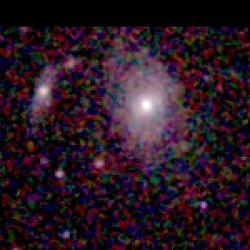| NGC 36 | |
|---|---|
 SDSS image of NGC 36 | |
| Observation data (J2000 epoch) | |
| Constellation | Pisces |
| Right ascension | 00h 11m 22.3s [1] |
| Declination | +06° 23′ 22″ [1] |
| Redshift | 0.020114 [1] |
| Heliocentric radial velocity | 6030 ± 4 km/s [1] |
| Distance | 221 Mly (67.7 Mpc) [2] |
| Apparent magnitude (V) | 14.0 [1] |
| Characteristics | |
| Type | SBb [3] |
| Apparent size (V) | 2.2′ × 1.3′ [1] |
| Other designations | |
| NGC 36, UGC 106, PGC 798, IRAS 00088+0606, IRAS F00088+0606, CGCG 408-040, CGCG 0008.8+0606, HIPASS J0011+06, MCG +01-01-043, UZC J001122.3+062321, 2MASX J00112231+0623212, [HDL96] 408-066, GC 19 [3] | |
NGC 36 is a barred spiral galaxy [3] in the constellation Pisces. It is located about 221 million light-years (68 megaparsecs) away. [2] It was discovered in October 25, 1785, by the astronomer William Herschel. [4]
Contents
